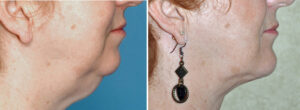Neck deformities, either of congenital or more commonly aging origin, are frequent sources of invasive and non-invasive procedures for improvement. At the opposite ends of the spectrum for neck contouring are injections (Kybella) and skin tightening devices to a full lower neck lift. (facelift) While each of these have their roles depending upon the magnitude of the neck contour deformity and the patient’s age, there are some patients that lie somewhere between the least invasive and the most invasive aesthetic neck reshaping treatment options.

In the 2020 Global Open Issue of Plastic and Reconstructive Surgery journal an article on this topic was published entitled ‘The Single Incision Minimally Invasive (SIMI) Neck Lift.’ In this clinical paper the author reviews a series of twenty (20) patients that received an isolated neck procedure consisting of a cervicomental incision through which is performed full neck liposuction, neck skin flap elevation, subplatsymal defatting and midline platysmal muscle plication. Candidates for this procedure were based on the Pythagorean theorem in which the loose neck skin must fall within the hypotenuse of the triangle.
Of the twenty patients only one complication was seen (hematoma) which was surgically resolved.

The cervicomental incision necklift adds to the surgeon’s repertoire of neck reshaping options. While its use may be limited to a very specific type of neck shape, it is another approach to offer the patient whose neck is beyond what non-surgical methods can improve but is not yet ready or needs a formal full lower necklift.
Dr. Barry Eppley
Indianapolis, Indiana


